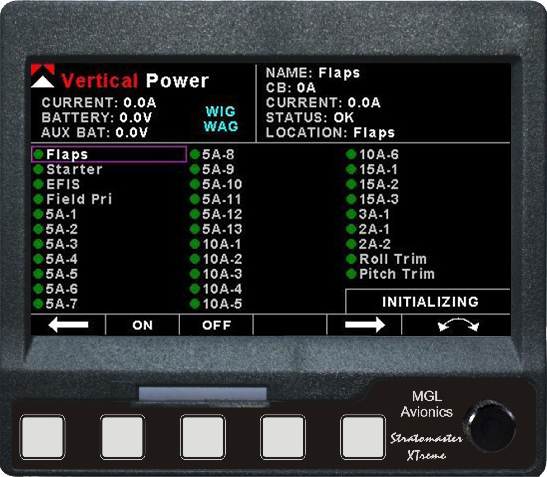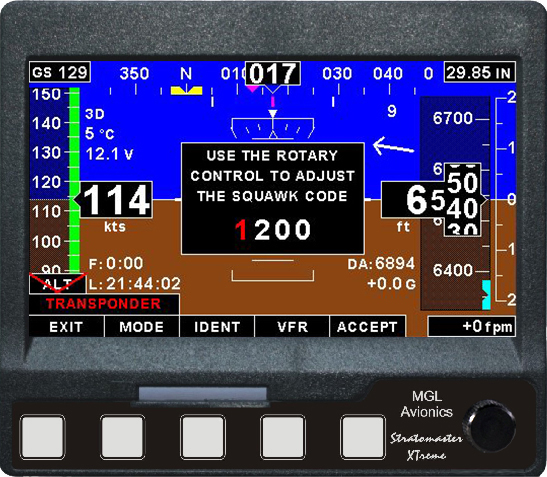XTreme
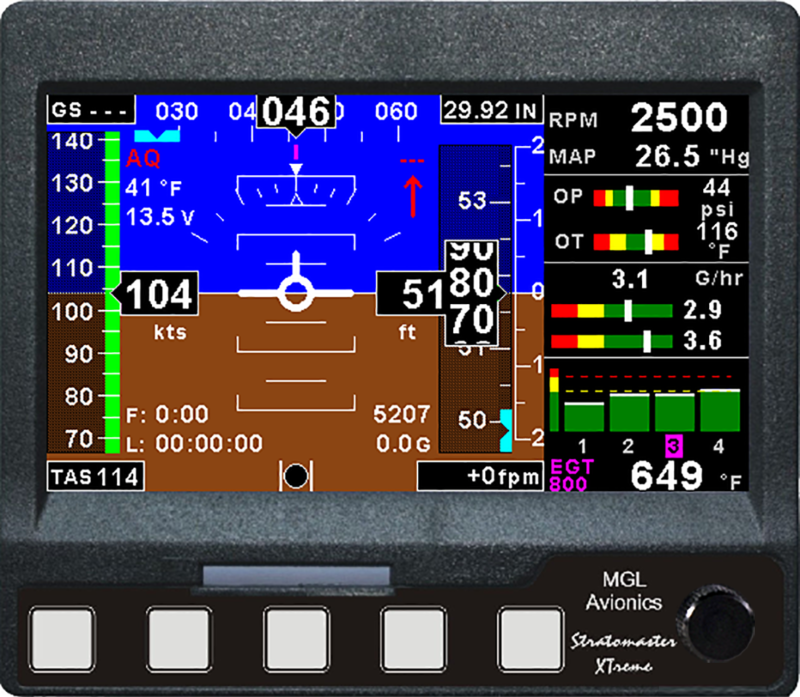
XTreme is an affordable mini EFIS
& full-featured Engine Monitoring System.
XTreme EFIS
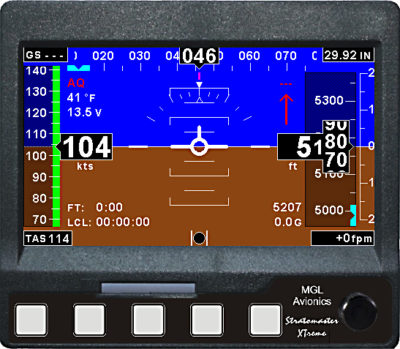
The XTreme EFIS is an affordable mini EFIS. It can be configured as a PFD , and/or an engine monitor. It includes a GPS receiver that is used to provide ground speed and range information, a basic CDI navigator, and as a backup/control for the AHRS. If you do not select the SP-7 attitude sensor, you can still have a GPS-derived bank angle display!
You can use it as…
- Primary EFIS
- Backup EFIS
- Engine Monitor
- EFIS/Engine Monitor
- Basic GPS Navigator with CDI (no moving map)
- 2-Axis Autopilot
Use it for just 1 function, or all functions!
XTreme can be connected to standard MGL Avionics AHRS sensors and RDAC (engine monitor) boxes. It also integrates a CAN communications interface and standard RS-232 ports.
XTreme EMS
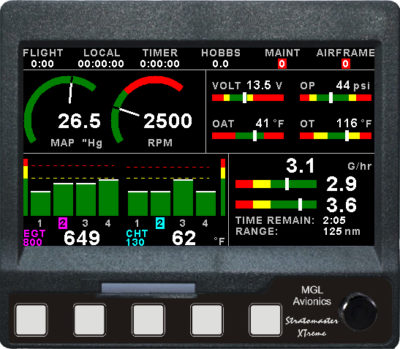
The XTreme EMS is a full-featured , full color Engine Monitoring System for just about any engine.
Using an MGL Avionics RDAC for engine sender connection in the engine compartment, all sensor data is sent through the firewall through a single serial cable, making installation clean and easy.
4 and 6 cylinder engines are fully supported, with up to 12 total channels of CHT or EGT available in any combination.
2 fuel level inputs are available and fuel flow is supported.
Battery voltage is standard and current monitoring is an available option.
An easy-to-read display with alarms on every channel make an engine instrument scan a 1-second affair!
It can be connected to standard MGL Avionics RDAC (engine monitor) boxes (required).
XTtreme EFIS Rear Panel
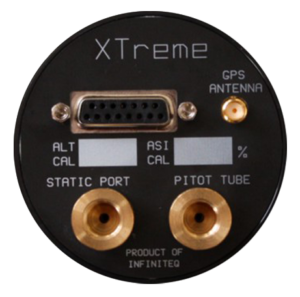
XTtreme EMS Rear Panel
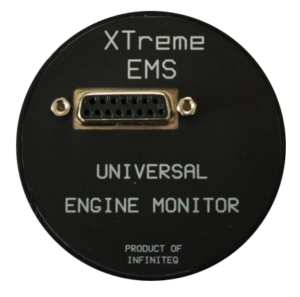
The XTreme units are based on a 4.3″ sunlight readable, wide viewing angle, high resolution LCD display. It integrates an SD card reader (for software updates and for engine data recorder), 5 function buttons, a rotary control.
Xtreme designed to fit a standard 3 1/8″ round instrument hole. The body is located off-center allowing the unit to replace instruments on the right side of a standard 6-pack configuration or any other location that currently occupies two instruments.
Due to the light weight and very low mounting depth no complicated mounting brackets or trays are needed. Power use is low and operation from much less than 12V to around 28V is fully supported.
XTreme EFIS units can share AHRS sensor and even RDAC engine sensor data for multiple EFIS setups. For dedicated engine monitoring the XTreme EMS can be installed and can share RDAC engine sensor data among multiple XTreme units including XTreme EMS and EFIS models.
XTreme EFIS
- SD Card interface for data recording, user splash screens, checklists, graphic information pages, firmware upgrades etc
- 1/8” NPT female fittings for Altitude and Airspeed pitot tube connections
- 2x RS232 communication ports
- 1x CAN communication port
- Rotary control plus 5 independent buttons for easy menu navigation and user input
- External alarm switch output for an external indicator lamp etc
- Built in 50 Channel GPS receiver with over 1 million effective correlators with high immunity to jamming
- Time To First Fix (TTFF) of less than 1 second
- External active GPS antenna connection
- Support for an internal or an external GPS receiver
- Built in RTC (Real Time Clock)
- Wide input supply voltage range of 8 to 30V DC
- Built in voltage reversal and over voltage protection for harsh electrical environments
- Light weight design
EFIS:
- Attitude display. (Note 1)
- Magnetic heading indication. (Note 2)
- GPS-derived bank angle if no Attitude sensor
- Heading bug
- Precision altimeter from –1000ft up to a maximum of 30 000ft (-304m to 9144m). Altitude can be displayed in ft or m
- Altitude bug
- Airspeed indicator (16mph to 250mph), 1mph resolution. Airspeed can be displayed in mph, km/h or kts
- Digital VSI indicator (+/-20 ft/min to +/-10 000 ft/min) and analog VSI indicator (+-2000 ft/min range). VSI can be displayed in ft/min or m/s.
- Serial Altitude encoder output via a RS232 port
- Density altimeter
- OAT (Outside Air Temperature) display using an external OAT probe
- Supply Voltage display
- Stopwatch timer
- Automatic flight timer
- RTC (Real Time Clock)
- Glide and climb ratio indicator
- Barometer (actual local pressure)
- TAS (True airspeed) display
- G-Force indication. (Note 1)
- Wind speed and wind direction indication. (Note 2)
- Turn Indicator. (Note 1)
- Slip/Skid indicator. (Note 1)
Engine Monitor: (Note 3)
- 1x Engine RPM
- 1x Rotor RPM (Note 5)
- 1x Manifold pressure (Note 6)
- 1x Oil pressure input
- 1x Oil temperature input
- 2x Auxiliary analog channels (Pressure/Temperature/Current)
- 12 Channel EGT/CHT display
- 2x Fuel Flow
- 2x Fuel Level
- Programmable maintenance timer for scheduled routine engine maintenance
- Engine display screens are automatically configured to optimize screen space depending on what
- parameters are been displayed
- Settable Hobbs meter (password protected)
- Fuel range / endurance based on TAS or GPS ground speed
- Supply Voltage display
- Current monitor to measure charge/discharge currents. (Note 4)
- Engine leaning feature
General:
- Alarms on most displays
- Programmable maintenance timer for scheduled routine engine maintenance
- Programmable airframe timer for scheduled airframe maintenance.
- Records maximum and minimum values of most displayed values
- Built in black box recorder – records all flight data, engine, attitude and GPS data to SD card. Data can be exported to Google Earth, Microsoft Excel, etc.
- Includes a 1000 entry automatic flight log (Records start date&time, flight time, pilot number, Hobbs time, maintenance time, max altitude, airspeed and VSI reached during the flight)
- User configurable start up (Splash) screen
- Unlimited configurable checklists
- Unlimited configurable graphic information displays
- Automatic or manual local magnetic variation
- Dual menu system for quick item selection and user setups
- Sunrise/Sunset calculator
- Firmware upgrades via SD Card
- 3 year limited warranty (MGL Avionics US)
(Note 1) Requires optional MGL Avionics AHRS sensor unit (SP-7/SP-5)
(Note 2) Requires optional MGL Avionics compass sensor unit (SP-6)
(Note 3) Requires optional MGL Avionics RDAC unit or direct connection with compatible ECU
(Note 4) Requires optional MGL Avionics current monitor sensor
(Note 5) Requires RDAC with Rotor RPM input
(Note 6) Requires RDAC with Manifold Pressure
XTreme EMS
- SD Card interface
for data recording, user splash screens, checklists, graphic information pages, firmware upgrades etc - 2x RS232 communication ports
- 1x CAN communication port
- Rotary control plus 5 independent buttons for easy menu navigation and user input
- External alarm switch output for an external indicator lamp etc
- Built in 50 Channel GPS receiver with over 1 million effective correlators with high immunity to jamming
- Built in RTC (Real Time Clock)
- Wide input supply voltage range of 8 to 30V DC
- Built in voltage reversal and over voltage protection for harsh electrical environments
- Light weight design
Engine Monitor: (Note 1)
- 1x Engine RPM
- 1x Rotor RPM (Note 3)
- 1x Manifold pressure (Note 4)
- 1x Oil pressure input
- 1x Oil temperature input
- 2x Auxiliary analog channels (Pressure/Temperature/Current)
- 12 Channel EGT/CHT display
- 2x Fuel Flow
- 2x Fuel Level
- Programmable maintenance timer for scheduled routine engine maintenance
- Engine display screens are automatically configured to optimize screen space depending on what
- parameters are been displayed
- Settable Hobbs meter (password protected)
- Fuel range / endurance
- Supply Voltage display
- Current monitor to measure charge/discharge currents. (Note 2)
- Engine leaning feature
General:
- Alarms on most displays
- Programmable maintenance timer for scheduled routine engine maintenance
- Programmable airframe timer for scheduled airframe maintenance.
- Records maximum and minimum values of most displayed values
- Built in black box recorder – records all engine data to SD card. Data can be exported to Microsoft Excel, etc.
- User configurable start up (Splash) screen
- Unlimited configurable checklists
- Unlimited configurable graphic information displays
- Dual menu system for quick item selection and user setups
- Firmware upgrades via SD Card
- 3 year limited warranty (MGL Avionics US)
(Note 1) All engine functions require MGL Avionics RDAC unit or direct connect with compatible ECU
(Note 2) Requires optional MGL Avionics current monitor sensor
(Note 3) Requires RDAC with Rotor RPM input
(Note 4) Requires RDAC with Manifold Pressure
RDAC
The XTreme offers comprehensive engine monitoring for any engine. All engine data is captured via our RDAC (Remote Data Acquisition Computer) that mounts near the engine (in front of or behind the firewall). This data acquisition computer then sends all sender data to the EFIS display via 1 serial cable. No wiring harness for engine senders required!
The XTreme support any one of our RDAC options:
- RDAC XF – All engine functions with 12-channels for thermocouples (CHT/EGT)
- RDAC XF MAP – All engine functions with 12-channels for thermocouples and manifold pressure (MAP)
- RDAC CAN 912iS/UL Power – Monitoring of these Engines are directly from the ECU via CAN (up to 2 of these can be used)
- RDAC XG – Lightweight 4-channel thermocouple RDAC best suited for water-cooled 4-cylinder engines
For Lycoming installations, the only choice is whether or not you want to monitor Manifold Pressure (RDAC XF or XF MAP).
Alarms:
Whenever an engine parameter is exceeded an alarm will be initiated. The alarm can be setup to be any or all of the following:
- On screen warning
- External contact (panel warning light)
SP-6, SP-7 & SP-9
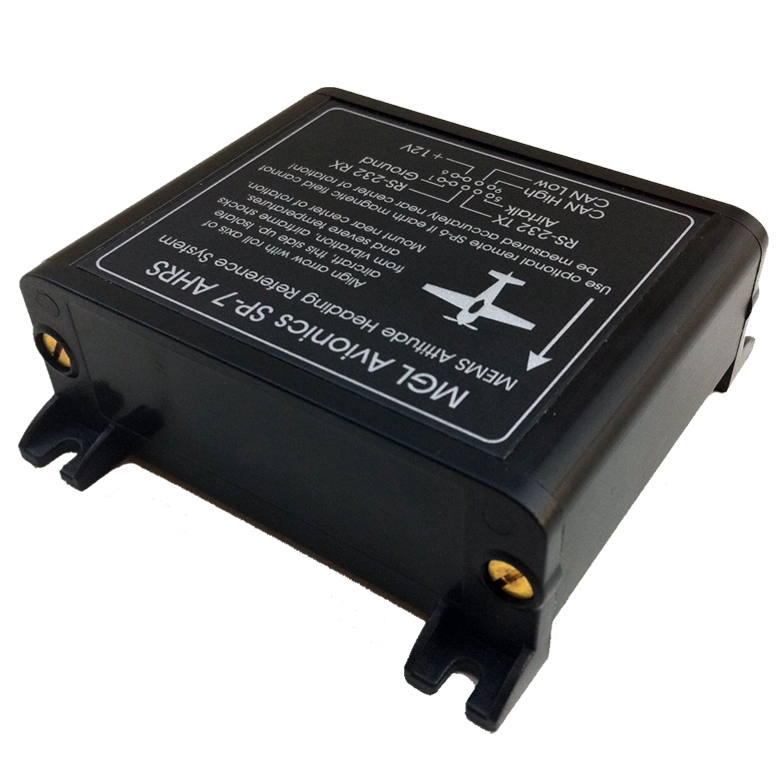
The latest MGL Avionics SP-6 (Compass) and SP-7 (Attitude) SP-9 (Combined) AHRS sensors can be used with the Xtreme EFIS. The AHRS sensors connect to the XTreme EFIS via an CAN communication line. The sensors can be shared among multiple XTreme EFIS units.
Built In Autopilot
The MGL Avionics XTreme EFIS contains a built-in autopilot. All you do is install our servos in the aircraft and the control and AP engage/disengage is handled directly by the XTreme EFIS screen.
Built-in GPS Basic Waypoint Navigation
The XTreme EFIS contains a built in GPS engine that allows for realtime accurate range and endurance functionality, as well as a basic GPS Navigator with CDI display.
Pressing the 2nd Keypad button brings up the Nearest Airports from the Navidata database on the SD card

Transponder Control
The XTreme EFIS’s powerhouse functionality is further extended through the Sandia Aerospace STX 165R Remote Mode-C transponder. Through just 2 wires, the XTreme EFIS sends encoded altitude to the STX 165R, displays status, controls its mode (OFF/STBY/ON/ALT), adjusts Squawk and Idents.
For recreational Part 91 flight in the US, mode-C meets the transponder requirements of the FAR’s, and this unit allows you to remove the transponder from the panel, mount it closer to its antenna, all while saving money and lowering current consumption.
Since most recreational pilots spend most of the time flying VFR and squawking 1200, or at most setting squawk once during flight, it makes sense to clean up the panel and mount the transponder away from other sensitive avionics
VPX Integration
The VP-X replaces old-style circuit breakers in the panel with an intelligent patented Electronic Circuit Breaker (ECB) system. Except, with the VP-X, if you have a circuit fault, the MGL Avionics EFIS alarm system will alert the pilot of the problem, and you will get an on-screen alarm with a precise reason for the fault (for example, short circuit or open circuit). And, you can reset the fault from the EFIS if necessary. The EFIS will also display current draw (Amps) of each device on the screen to help you manage electrical load.
Devices are still turned on an off with switches in the instrument panel, however, current does not flow through the switches to the devices, so you don’t have a ‘hot’ panel with lots of wiring and busses. Wiring is greatly simplified since each device gets a hot lead from the VP-X and then each switch gets a separate lead. The software setup of the VP-X assigns which switch turns on which device.
The VP-X has a host of intelligent functions, and can control trim, flaps and landing lights. A complete detail of the functions is available at the Vertical Power web site.
